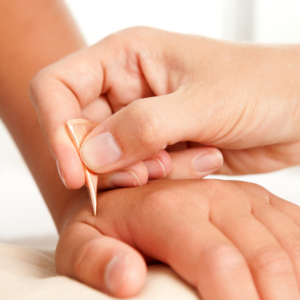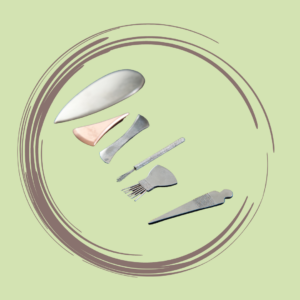Chinese Medicine theory and diagnosis is very well suited to the kinds of problems children mainly present with. The problem often is that parents hold a perception that their child will simply not tolerate any needles. Though the reality is rather different and the vast majority of children accept being needled. However, when parents or children do not want needles to be used, the Chinese medicine practitioner has plenty of other tools to use. One of these tools is so called Shonishin or “Children’s Needle”.
 What is Shonishin or the Children’s needle?
What is Shonishin or the Children’s needle?
Shonishin is more commonly known as paediatric acupuncture, though typically no needles are used and nothing actually penetrates the skin. It is a gentle, mostly non-insertion style of Japanese acupuncture used to treat babies, toddlers and small children. It uses small metal tools to scratch, tap, or brush on the child’s skin over acupuncture pathways. This treatment is painless and gently relaxes and simulates the child’s body back into balance.
What are the benefits of using Shonishin treatment for children?
- It is applied without using needles.
- In most cases, children enjoy the treatment.
- The treatment time is short and children don’t need to stay still for a long time.
- It is light and non-invasive and can bring about profound changes in a baby or a child.
- Parents can be taught to apply the treatment at home.

How is Shonishin applied?
Shonishin can be used when treating babies and children of any age. It is applied using a range of tools. The practitioner strokes and taps the different parts of the body with these tools. Some examples of the tools are shown in the picture.
What is the clinical effect of Shonishin?
There are different ways of understanding how Shonishin works. It is described in the literature that it has the ability to restore and stimulate the body’s natural healing mechanisms.
Research in Sweden has shown that the stroking may also lead to the release of oxytocin in the body, which is known to have a strong calming effect.
A simple explanation is that it helps to counteract the tendency of qi (energy) in the child to rise up to the head. This rising qi can account for many of the conditions for which children seek most commonly treatment, for example asthma, insomnia, hyperactivity, vomiting and headaches, just to name a few.
Are there contra-indications for using Shonishin?
Shonishin should not be carried out in children that have a fever, as it can temporarily raise the body temperature of the child.
It should also not be carried out over broken skin or skin lesions, in case of conditions such as eczema. It is possible to go around these areas, just not over them.
Is Shonishin a good treatment for my child?
The best way of finding out if Shonishin can benefit your child is to see a Chinese medicine practitioner that is trained in paediatric acupuncture. A personalised diagnostic process is necessary to find out what the best method is to treat the child.
Here at Natural Solutions Acupuncture Marieke is trained in paediatrics and has helped many little ones to become healthier and happier.
How do I make an appointment?
You can go to our online booking system here and choose Paediatric Acupuncture to make a booking. You can also give us a call on 0414 067 874 if you have any queries.

